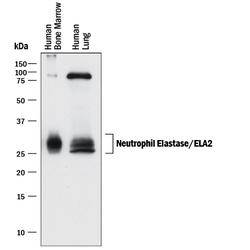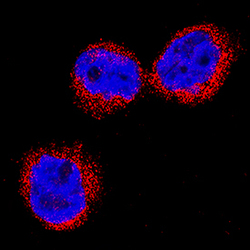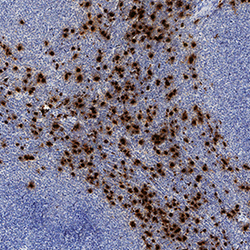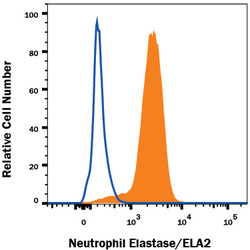Antibody data
- Antibody Data
- Antigen structure
- References [1]
- Comments [0]
- Validations
- Western blot [1]
- Immunocytochemistry [1]
- Immunohistochemistry [1]
- Flow cytometry [1]
Submit
Validation data
Reference
Comment
Report error
- Product number
- MAB91671-100 - Provider product page

- Provider
- R&D Systems
- Product name
- Human Neutrophil Elastase/ELA2 Antibody
- Antibody type
- Monoclonal
- Description
- Protein A or G purified from hybridoma culture supernatant. Detects human ELA2 in direct ELISAs and Western blots.
- Reactivity
- Human
- Host
- Mouse
- Conjugate
- Unconjugated
- Antigen sequence
P08246- Isotype
- IgG
- Antibody clone number
- 950317
- Vial size
- 100 ug
- Storage
- Use a manual defrost freezer and avoid repeated freeze-thaw cycles. 12 months from date of receipt, -20 to -70 °C as supplied. 1 month, 2 to 8 °C under sterile conditions after reconstitution. 6 months, -20 to -70 °C under sterile conditions after reconstitution.
Submitted references A Novel Compound, "FA-1" Isolated from Prunus mume, Protects Human Bronchial Epithelial Cells and Keratinocytes from Cigarette Smoke Extract-Induced Damage.
Jang AJ, Lee JH, Yotsu-Yamashita M, Park J, Kye S, Benza RL, Passineau MJ, Jeon YJ, Nyunoya T
Scientific reports 2018 Jul 31;8(1):11504
Scientific reports 2018 Jul 31;8(1):11504
No comments: Submit comment
Supportive validation
- Submitted by
- R&D Systems (provider)
- Main image

- Experimental details
- Detection of Human Neutrophil Elastase/ELA2 by Western Blot. Western blot shows lysates of human bone marrow and human lung tissue. PVDF membrane was probed with 0.1 µg/mL of Mouse Anti-Human Neutrophil Elastase/ELA2 Monoclonal Antibody (Catalog # MAB91671) followed by HRP-conjugated Anti-Mouse IgG Secondary Antibody (Catalog # HAF018). Specific bands were detected for Neutrophil Elastase/ELA2 at approximately 25-30 kDa (as indicated). This experiment was conducted under reducing conditions and using Immunoblot Buffer Group 1.
Supportive validation
- Submitted by
- R&D Systems (provider)
- Main image

- Experimental details
- Neutrophil Elastase/ELA2 in THP-1 Human Cell Line. Neutrophil Elastase/ELA2 was detected in immersion fixed THP-1 human acute monocytic leukemia cell line using Mouse Anti-Human Neutrophil Elastase/ELA2 Monoclonal Antibody (Catalog # MAB91671) at 5 µg/mL for 3 hours at room temperature. Cells were stained using the NorthernLights™ 557-conjugated Anti-Mouse IgG Secondary Antibody (red; Catalog # NL007) and counterstained with DAPI (blue). Specific staining was localized to cytoplasm. View our protocol for Fluorescent ICC Staining of Non-adherent Cells.
Supportive validation
- Submitted by
- R&D Systems (provider)
- Main image

- Experimental details
- Neutrophil Elastase/ELA2 in Human Lymphoma. Neutrophil Elastase/ELA2 was detected in immersion fixed paraffin-embedded sections of human lymphoma using Mouse Anti-Human Neutrophil Elastase/ELA2 Monoclonal Antibody (Catalog # MAB91671) at 5 µg/mL for 1 hour at room temperature followed by incubation with the Anti-Mouse IgG VisUCyte™ HRP Polymer Antibody (Catalog # VC001). Tissue was stained using DAB (brown) and counterstained with hematoxylin (blue). Specific staining was localized to cytoplasm. View our protocol for IHC Staining with VisUCyte HRP Polymer Detection Reagents.
Supportive validation
- Submitted by
- R&D Systems (provider)
- Main image

- Experimental details
- Detection of Neutrophil Elastase/ELA2 in THP-1 Human Cell Line by Flow Cytometry. THP-1 human acute monocytic leukemia cell line treated with 3 μM monensin for 3 hours was stained with Mouse Anti-Human Neutrophil Elastase/ELA2 Monoclonal Antibody (Catalog # MAB91671, filled histogram) or isotype control antibody (Catalog # MAB002, open histogram), followed by Phycoerythrin-conjugated Anti-Mouse IgG Secondary Antibody (Catalog # F0102B). To facilitate intracellular staining, cells were fixed with Flow Cytometry Fixation Buffer (Catalog # FC004) and permeabilized with Flow Cytometry Permeabilization/Wash Buffer I (Catalog # FC005). View our protocol for Staining Intracellular Molecules.
 Explore
Explore Validate
Validate Learn
Learn Western blot
Western blot